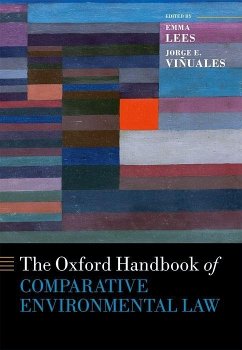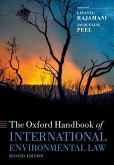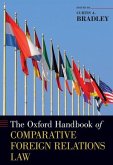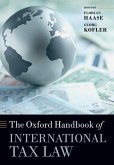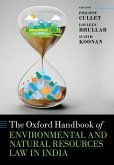Oxford Handbook of Comparative Environmental Law
Herausgeber: Vinuales, Jorge; Lees, Emma
Oxford Handbook of Comparative Environmental Law
Herausgeber: Vinuales, Jorge; Lees, Emma
- Gebundenes Buch
- Merkliste
- Auf die Merkliste
- Bewerten Bewerten
- Teilen
- Produkt teilen
- Produkterinnerung
- Produkterinnerung
This Handbook brings together the foremost authorities from around the world to provide the first comprehensive account of comparative environmental law. It examines in detail the methodological foundations of the discipline as well as the substance of environmental law across countries.
Andere Kunden interessierten sich auch für
![The Oxford Handbook of International Environmental Law The Oxford Handbook of International Environmental Law]() The Oxford Handbook of International Environmental Law321,99 €
The Oxford Handbook of International Environmental Law321,99 €![The Oxford Handbook of Comparative Health Law The Oxford Handbook of Comparative Health Law]() The Oxford Handbook of Comparative Health Law297,99 €
The Oxford Handbook of Comparative Health Law297,99 €![The Oxford Handbook of Comparative Foreign Relations Law The Oxford Handbook of Comparative Foreign Relations Law]() The Oxford Handbook of Comparative Foreign Relations Law244,99 €
The Oxford Handbook of Comparative Foreign Relations Law244,99 €![The Oxford Handbook of International Tax Law The Oxford Handbook of International Tax Law]() The Oxford Handbook of International Tax Law225,99 €
The Oxford Handbook of International Tax Law225,99 €![The Oxford Handbook of International Law and Development The Oxford Handbook of International Law and Development]() Ruth BuchananThe Oxford Handbook of International Law and Development226,99 €
Ruth BuchananThe Oxford Handbook of International Law and Development226,99 €![The Oxford Handbook of the Law of the Sea The Oxford Handbook of the Law of the Sea]() The Oxford Handbook of the Law of the Sea293,99 €
The Oxford Handbook of the Law of the Sea293,99 €![Oxford Handbook of Environmental and Natural Resources Law in India Oxford Handbook of Environmental and Natural Resources Law in India]() Philippe CulletOxford Handbook of Environmental and Natural Resources Law in India226,99 €
Philippe CulletOxford Handbook of Environmental and Natural Resources Law in India226,99 €-
-
-
This Handbook brings together the foremost authorities from around the world to provide the first comprehensive account of comparative environmental law. It examines in detail the methodological foundations of the discipline as well as the substance of environmental law across countries.
Hinweis: Dieser Artikel kann nur an eine deutsche Lieferadresse ausgeliefert werden.
Hinweis: Dieser Artikel kann nur an eine deutsche Lieferadresse ausgeliefert werden.
Produktdetails
- Produktdetails
- Verlag: Hurst & Co.
- Seitenzahl: 1328
- Erscheinungstermin: 25. Juni 2019
- Englisch
- Abmessung: 249mm x 173mm x 66mm
- Gewicht: 1905g
- ISBN-13: 9780198790952
- ISBN-10: 0198790953
- Artikelnr.: 55311130
- Herstellerkennzeichnung
- Libri GmbH
- Europaallee 1
- 36244 Bad Hersfeld
- gpsr@libri.de
- Verlag: Hurst & Co.
- Seitenzahl: 1328
- Erscheinungstermin: 25. Juni 2019
- Englisch
- Abmessung: 249mm x 173mm x 66mm
- Gewicht: 1905g
- ISBN-13: 9780198790952
- ISBN-10: 0198790953
- Artikelnr.: 55311130
- Herstellerkennzeichnung
- Libri GmbH
- Europaallee 1
- 36244 Bad Hersfeld
- gpsr@libri.de
Emma Lees is University Lecturer in Environmental and Property Law at University of Cambridge and is the Deputy-Director of the Centre for Environment, Energy, and Natural Resource Governance (C-EERNG), and a fellow of the Centre for Property Law. She is also a fellow of Fitzwilliam College, Cambridge. Jorge E. Viñuales holds the Harold Samuel Chair of Law and Environmental Policy at the University of Cambridge and is the founder and former Director of the Cambridge Centre for Environment, Energy and Natural Resource Governance (C-EENRG). He is also the Chairman of the Compliance Committee of the UN-ECE/WHO-Europe Protocol on Water and Health, a member of the Panel of Arbitrators of the Shanghai International Arbitration Centre, the Director-General of the Latin American Society of International Law, and an Of Counsel with Lalive. Prior to joining Cambridge, he was the Pictet Chair of International Environmental Law at the Graduate Institute, Geneva, where he keeps a limited affiliation. Professor Viñuales is also a fellow of Clare College, Cambridge, and of the Lauterpacht Centre for International Law.
* Framing comparative environmental law
* 1: Jorge E. Viñuales: Comparative environmental law: Structuring a
field
* 2: Emma Lees: Value in comparative law - 3D Cartography and
analytical description
* Part I: Country studies
* 3: Douglas Fisher: Australia
* 4: Antonio Benjamin and Nicholas Bryner: Brazil
* 5: Stepan Wood: Canada
* 6: Wang Xi: People's Republic of China
* 7: Markus Gehring, Freedom-Kai Phillips, Emma Lees: The European
Union
* 8: Laurent Neyret: France
* 9: Olaf Dilling and Wolfgang Köck: Germany
* 10: Bharat Desai and Balraj K. Sidhu: India
* 11: Simon Butt and Prayekti Murharjanti: Indonesia
* 12: Julius Weitzdörfer and Lucy Lu Reimers: Japan
* 13: Marisol Anglés Hernández and Monserrat Rovalo: Mexico
* 14: Lye Lin-Heng: Singapore
* 15: Jan Glazewski: South Africa
* 16: Hong Sik Cho and Gina J. Choi: South Korea
* 17: Stuart Bell: United Kingdom
* 18: James Salzman: United States of America
* Part II: Problems
* 19: Massimiliano Montini: Atmospheric pollution
* 20: Dan Tarlock: Environmental regulation of freshwater
* 21: Ben Boer and Ian Hannam: Land degradation
* 22: Agustin Garcia Ureta: Nature conservation
* 23: Till Markus: Regulation of marine-capture fisheries
* 24: Anne Saab: Genetically modified organisms
* 25: Justin Gundlach and Michael Gerrard: Climate change and energy
transition policies
* 26: Lucas Bergkamp and Adam Abelkop: Regulation of chemicals
* 27: Natalie Jones and Geert van Calster: Waste regulation
* 28: Emma Lees: Contaminated sites
* Part III: Systems
* A. Infrastructure
* 29: Eloise Scotford: Environmental principles across jurisdictions:
Legal connectors and catalysts
* 30: Moritz Reese: Distribution of powers
* 31: Christopher P. Rodgers: Property systems and environmental
regulation
* 32: Brian Preston: Regulatory organisation
* 33: Elizabeth Fisher: Sciences, environmental laws, and legal
cultures: Fostering collective epistemic responsibilities
* 34: Veerle Heyvaert: Transnational networks
* 35: Emma Lees: Adjudication systems
* B. Policy instruments
* Command and control regulation
* 36: Wang Jin: Environmental planning
* 37: Colin Reid: Protection of sites
* 38: Bettina Lange: Command and control standards and
cross-jurisdictional harmonization
* 39: Neil Craik: The assessment of environmental impact
* Market mechanisms
* 40: Janet Milne: Environmental taxation
* 41: Sanja Bogojevic: Trading schemes
* Informational techniques
* 42: Amy Cutter-McKenzie, Marianne Logan, Ferdousi Khatun, Karen
Malone: A cartography of environmental education
* 43: Karen Morrow: Informational requirements and environmental
protection
* 44: Jason Czarnezki, Margot Pollans, Sarah Main: Eco-labelling
* Ex post injury-based mechanisms
* 45: Monika Hinteregger: Environmental liability
* 46: Louis Kotze and Erin Daly: A cartography of environmental human
rights
* Part IV: Legal context
* 47: Ole Pedersen: Environmental law and constitutional and public law
* 48: David Howarth: Environmental law and private law
* 49: Emma Lees: Environmental law and criminal law
* 50: Geert van Calster: Environmental law in private international law
* 51: Leslie-Anne Duvic Paoli: Environmental law and public
international law
* 1: Jorge E. Viñuales: Comparative environmental law: Structuring a
field
* 2: Emma Lees: Value in comparative law - 3D Cartography and
analytical description
* Part I: Country studies
* 3: Douglas Fisher: Australia
* 4: Antonio Benjamin and Nicholas Bryner: Brazil
* 5: Stepan Wood: Canada
* 6: Wang Xi: People's Republic of China
* 7: Markus Gehring, Freedom-Kai Phillips, Emma Lees: The European
Union
* 8: Laurent Neyret: France
* 9: Olaf Dilling and Wolfgang Köck: Germany
* 10: Bharat Desai and Balraj K. Sidhu: India
* 11: Simon Butt and Prayekti Murharjanti: Indonesia
* 12: Julius Weitzdörfer and Lucy Lu Reimers: Japan
* 13: Marisol Anglés Hernández and Monserrat Rovalo: Mexico
* 14: Lye Lin-Heng: Singapore
* 15: Jan Glazewski: South Africa
* 16: Hong Sik Cho and Gina J. Choi: South Korea
* 17: Stuart Bell: United Kingdom
* 18: James Salzman: United States of America
* Part II: Problems
* 19: Massimiliano Montini: Atmospheric pollution
* 20: Dan Tarlock: Environmental regulation of freshwater
* 21: Ben Boer and Ian Hannam: Land degradation
* 22: Agustin Garcia Ureta: Nature conservation
* 23: Till Markus: Regulation of marine-capture fisheries
* 24: Anne Saab: Genetically modified organisms
* 25: Justin Gundlach and Michael Gerrard: Climate change and energy
transition policies
* 26: Lucas Bergkamp and Adam Abelkop: Regulation of chemicals
* 27: Natalie Jones and Geert van Calster: Waste regulation
* 28: Emma Lees: Contaminated sites
* Part III: Systems
* A. Infrastructure
* 29: Eloise Scotford: Environmental principles across jurisdictions:
Legal connectors and catalysts
* 30: Moritz Reese: Distribution of powers
* 31: Christopher P. Rodgers: Property systems and environmental
regulation
* 32: Brian Preston: Regulatory organisation
* 33: Elizabeth Fisher: Sciences, environmental laws, and legal
cultures: Fostering collective epistemic responsibilities
* 34: Veerle Heyvaert: Transnational networks
* 35: Emma Lees: Adjudication systems
* B. Policy instruments
* Command and control regulation
* 36: Wang Jin: Environmental planning
* 37: Colin Reid: Protection of sites
* 38: Bettina Lange: Command and control standards and
cross-jurisdictional harmonization
* 39: Neil Craik: The assessment of environmental impact
* Market mechanisms
* 40: Janet Milne: Environmental taxation
* 41: Sanja Bogojevic: Trading schemes
* Informational techniques
* 42: Amy Cutter-McKenzie, Marianne Logan, Ferdousi Khatun, Karen
Malone: A cartography of environmental education
* 43: Karen Morrow: Informational requirements and environmental
protection
* 44: Jason Czarnezki, Margot Pollans, Sarah Main: Eco-labelling
* Ex post injury-based mechanisms
* 45: Monika Hinteregger: Environmental liability
* 46: Louis Kotze and Erin Daly: A cartography of environmental human
rights
* Part IV: Legal context
* 47: Ole Pedersen: Environmental law and constitutional and public law
* 48: David Howarth: Environmental law and private law
* 49: Emma Lees: Environmental law and criminal law
* 50: Geert van Calster: Environmental law in private international law
* 51: Leslie-Anne Duvic Paoli: Environmental law and public
international law
* Framing comparative environmental law
* 1: Jorge E. Viñuales: Comparative environmental law: Structuring a
field
* 2: Emma Lees: Value in comparative law - 3D Cartography and
analytical description
* Part I: Country studies
* 3: Douglas Fisher: Australia
* 4: Antonio Benjamin and Nicholas Bryner: Brazil
* 5: Stepan Wood: Canada
* 6: Wang Xi: People's Republic of China
* 7: Markus Gehring, Freedom-Kai Phillips, Emma Lees: The European
Union
* 8: Laurent Neyret: France
* 9: Olaf Dilling and Wolfgang Köck: Germany
* 10: Bharat Desai and Balraj K. Sidhu: India
* 11: Simon Butt and Prayekti Murharjanti: Indonesia
* 12: Julius Weitzdörfer and Lucy Lu Reimers: Japan
* 13: Marisol Anglés Hernández and Monserrat Rovalo: Mexico
* 14: Lye Lin-Heng: Singapore
* 15: Jan Glazewski: South Africa
* 16: Hong Sik Cho and Gina J. Choi: South Korea
* 17: Stuart Bell: United Kingdom
* 18: James Salzman: United States of America
* Part II: Problems
* 19: Massimiliano Montini: Atmospheric pollution
* 20: Dan Tarlock: Environmental regulation of freshwater
* 21: Ben Boer and Ian Hannam: Land degradation
* 22: Agustin Garcia Ureta: Nature conservation
* 23: Till Markus: Regulation of marine-capture fisheries
* 24: Anne Saab: Genetically modified organisms
* 25: Justin Gundlach and Michael Gerrard: Climate change and energy
transition policies
* 26: Lucas Bergkamp and Adam Abelkop: Regulation of chemicals
* 27: Natalie Jones and Geert van Calster: Waste regulation
* 28: Emma Lees: Contaminated sites
* Part III: Systems
* A. Infrastructure
* 29: Eloise Scotford: Environmental principles across jurisdictions:
Legal connectors and catalysts
* 30: Moritz Reese: Distribution of powers
* 31: Christopher P. Rodgers: Property systems and environmental
regulation
* 32: Brian Preston: Regulatory organisation
* 33: Elizabeth Fisher: Sciences, environmental laws, and legal
cultures: Fostering collective epistemic responsibilities
* 34: Veerle Heyvaert: Transnational networks
* 35: Emma Lees: Adjudication systems
* B. Policy instruments
* Command and control regulation
* 36: Wang Jin: Environmental planning
* 37: Colin Reid: Protection of sites
* 38: Bettina Lange: Command and control standards and
cross-jurisdictional harmonization
* 39: Neil Craik: The assessment of environmental impact
* Market mechanisms
* 40: Janet Milne: Environmental taxation
* 41: Sanja Bogojevic: Trading schemes
* Informational techniques
* 42: Amy Cutter-McKenzie, Marianne Logan, Ferdousi Khatun, Karen
Malone: A cartography of environmental education
* 43: Karen Morrow: Informational requirements and environmental
protection
* 44: Jason Czarnezki, Margot Pollans, Sarah Main: Eco-labelling
* Ex post injury-based mechanisms
* 45: Monika Hinteregger: Environmental liability
* 46: Louis Kotze and Erin Daly: A cartography of environmental human
rights
* Part IV: Legal context
* 47: Ole Pedersen: Environmental law and constitutional and public law
* 48: David Howarth: Environmental law and private law
* 49: Emma Lees: Environmental law and criminal law
* 50: Geert van Calster: Environmental law in private international law
* 51: Leslie-Anne Duvic Paoli: Environmental law and public
international law
* 1: Jorge E. Viñuales: Comparative environmental law: Structuring a
field
* 2: Emma Lees: Value in comparative law - 3D Cartography and
analytical description
* Part I: Country studies
* 3: Douglas Fisher: Australia
* 4: Antonio Benjamin and Nicholas Bryner: Brazil
* 5: Stepan Wood: Canada
* 6: Wang Xi: People's Republic of China
* 7: Markus Gehring, Freedom-Kai Phillips, Emma Lees: The European
Union
* 8: Laurent Neyret: France
* 9: Olaf Dilling and Wolfgang Köck: Germany
* 10: Bharat Desai and Balraj K. Sidhu: India
* 11: Simon Butt and Prayekti Murharjanti: Indonesia
* 12: Julius Weitzdörfer and Lucy Lu Reimers: Japan
* 13: Marisol Anglés Hernández and Monserrat Rovalo: Mexico
* 14: Lye Lin-Heng: Singapore
* 15: Jan Glazewski: South Africa
* 16: Hong Sik Cho and Gina J. Choi: South Korea
* 17: Stuart Bell: United Kingdom
* 18: James Salzman: United States of America
* Part II: Problems
* 19: Massimiliano Montini: Atmospheric pollution
* 20: Dan Tarlock: Environmental regulation of freshwater
* 21: Ben Boer and Ian Hannam: Land degradation
* 22: Agustin Garcia Ureta: Nature conservation
* 23: Till Markus: Regulation of marine-capture fisheries
* 24: Anne Saab: Genetically modified organisms
* 25: Justin Gundlach and Michael Gerrard: Climate change and energy
transition policies
* 26: Lucas Bergkamp and Adam Abelkop: Regulation of chemicals
* 27: Natalie Jones and Geert van Calster: Waste regulation
* 28: Emma Lees: Contaminated sites
* Part III: Systems
* A. Infrastructure
* 29: Eloise Scotford: Environmental principles across jurisdictions:
Legal connectors and catalysts
* 30: Moritz Reese: Distribution of powers
* 31: Christopher P. Rodgers: Property systems and environmental
regulation
* 32: Brian Preston: Regulatory organisation
* 33: Elizabeth Fisher: Sciences, environmental laws, and legal
cultures: Fostering collective epistemic responsibilities
* 34: Veerle Heyvaert: Transnational networks
* 35: Emma Lees: Adjudication systems
* B. Policy instruments
* Command and control regulation
* 36: Wang Jin: Environmental planning
* 37: Colin Reid: Protection of sites
* 38: Bettina Lange: Command and control standards and
cross-jurisdictional harmonization
* 39: Neil Craik: The assessment of environmental impact
* Market mechanisms
* 40: Janet Milne: Environmental taxation
* 41: Sanja Bogojevic: Trading schemes
* Informational techniques
* 42: Amy Cutter-McKenzie, Marianne Logan, Ferdousi Khatun, Karen
Malone: A cartography of environmental education
* 43: Karen Morrow: Informational requirements and environmental
protection
* 44: Jason Czarnezki, Margot Pollans, Sarah Main: Eco-labelling
* Ex post injury-based mechanisms
* 45: Monika Hinteregger: Environmental liability
* 46: Louis Kotze and Erin Daly: A cartography of environmental human
rights
* Part IV: Legal context
* 47: Ole Pedersen: Environmental law and constitutional and public law
* 48: David Howarth: Environmental law and private law
* 49: Emma Lees: Environmental law and criminal law
* 50: Geert van Calster: Environmental law in private international law
* 51: Leslie-Anne Duvic Paoli: Environmental law and public
international law

